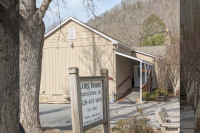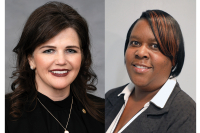WCU breaks enrollment records — again
 WCU students flood the center of campus after returning from summer break. WCU photo
WCU students flood the center of campus after returning from summer break. WCU photo
Western Carolina University’s enrollment hit an all-time high this fall for the seventh out of the past eight years, with the population of student Catamounts increasing 5.48 percent over fall 2017 — roughly twice the enrollment increase Western was aiming for.
“We were shooting for a lower number,” Sam Miller, WCU’s vice chancellor for student affairs, told trustees during a Sept. 6 committee meeting. “It came in a little hotter than we expected or actually intended.”
Big numbers for 2018
Fall 2018 marked the first semester of the N.C. Promise Tuition Plan, which brought in-state tuition for undergraduate students down to $500 per semester at three UNC System schools, including Western. WCU staff members were prepared for a surge of interest in attending Western, shortening deadlines and adjusting marketing strategies in hopes of drawing fewer applications.
It worked. According to unofficial census statistics, the university received 19,341 applications for admission to the freshman class, down 0.7 percent from 2017, when 19,477 people applied. However, those applications were of a higher quality than previous years, and more were admitted — WCU extended offers of admission to 7,667 applicants, up 1.5 percent from the 7,554 offers it extended last year. Of those receiving offers of admission, 28.8 percent accepted, up from 26.4 percent fall 2017, which was up from 25.9 percent fall 2016.
The university also saw a marked enrollment increase from transfer students, of which there were 1,105 in fall 2018 compared to 786 in fall 2017 — a 40.59 percent increase, according to unofficial numbers.
Related Items
While the number of first-time, full-time freshmen is steadily rising, so is the average GPA and SAT score. The average fall 2018 freshman came in with a 3.92 weighted high school GPA and an SAT score of 1149. That’s up from a 3.83 weighted GPA in fall 2017 and a 3.78 GPA in fall 2016. Similarly, the average SAT score was 1115 in fall 2017 and 1085 in fall 2016.
“It was an amazing census. We had amazing outcomes this year,” Miller told trustees.
This year’s student body showed some shifts in racial makeup over last year. The number of people identifying as American Indian or Alaska Native increased 33.78 percent, from 74 students to 99, and the percentage of Hispanic students increased 11.3 percent from 706 to 786. The number of people responding that their race and ethnicity is unknown or that they’re two or more races increased 9.3 percent, rising from 535 in fall 2017 to 585 this academic year. The number of white students increased 5.7 percent —0.22 percent more than the overall enrollment increase — rising from 8,673 to 9,164.
“One of the things we did very intentionally this past admission cycle is to try to stay true to our roots as a regionally engaged university,” Miller said. “We did make efforts to recruit here in the western part of the county.”
That — and in particular the Cherokee-focused efforts WCU has implemented over the past couple years — could have spurred the increase in Native American students, Miller said, with Trustee Joyce Dugan, a former principal chief of the Eastern Band of Cherokee Indians, adding that WCU Cherokee Center Director Sky Sampson has likely contributed to the outcome since coming on board in 2016.
However, diversity metrics are down in other categories. The number of students from foreign countries studying at WCU dropped from 223 to 186, a 22.2 percent decrease. The number of African American students dropped slightly from 687 to 683, but the increase in students identifying as two or more races could account for that discrepancy, Miller said.
“We are pleased with what we’re seeing,” said Miller. “We got a lot more students from some of the eastern high schools than we usually do, but they’re such small high schools we need to also be efficient down east in some of the population centers.”
More than N.C. Promise
While the coming of N.C. Promise has certainly spurred interest in WCU over the past few years, enrollment has been on the upswing for the past decade. Since 2008, WCU’s enrollment has increased by 2,589 students, or nearly 29 percent. This year marked the first time in university history that the number of first-time, full-time freshmen surpassed the 2,000 mark with a freshman class of 2,189 — 10.5 percent larger than last year’s freshman class of 1,980.
“Western Carolina University has long been known as an incredible higher education value, offering high-quality academic programs at an affordable cost,” said Interim Chancellor Alison Morrison-Shetlar. “With the onset of the N.C. Promise tuition plan, a Western Carolina University education becomes an even better value for our students and their parents.”
In 2017, the school’s marketing department decided to conduct a freshman survey to better understand what drives students’ decision to attend WCU. While the survey was entirely voluntarily and not designed to be a statistically valid study, it gives a snapshot of what influenced the decisions of 672 of fall 2017’s 1,980 freshmen.
Survey results showed academic program availability, academic quality, affordability and location as being the biggest drivers. For each factor listed, students could respond “small role,” “no role,” “no opinion,” “large role” or “deciding factor” on the question of how it played into their decision to attend. For the top four categories, the combined percentage for those who said each was a deciding factor or played a large role was 78 percent for academic program availability, 79 percent for academic quality, 66 percent for affordability and 63 percent for location.
By contrast, only 12.3 percent said not being able to afford their first choice was a deciding factor or played a large role; 18.5 percent said the same about wanting to go to college near home, 15.8 percent about being influenced by friends who were attending and 11.9 percent about parents or family wanting them to attend WCU.
The survey also showed student activities to be a significant driver of decisions to attend. While activities didn’t make the top tier when looking at the combined percentage of “deciding factor” and “large role,” they came in fourth when looking at “deciding factor” only. Of the 672 survey respondents, 12 percent said student activities were the deciding factor, with the marching band “first and foremost” among specifically mentioned programs, WCU Chief Marketing Officer Robin Oliver told trustees Sept. 6. Typically, 10 to 12 percent of WCU’s freshman class joins the Pride of the Mountains Marching Band, a startling number compared to the national average of 0.8 percent of freshmen joining the band.
“I think the biggest takeaway for us in marketing after this survey is that programs are really important to students, particularly undergraduate students,” Oliver said.
Thus far WCU hasn’t focused its marketing efforts around activities, but the survey results could spur a shift.
“What we took away from this is we don’t need to ignore programs,” she said.
A growing list of academic offerings could also be a factor, with new programs in subject areas including engineering, forensic anthropology, doctor of nursing practice, and doctorate-level psychology.









